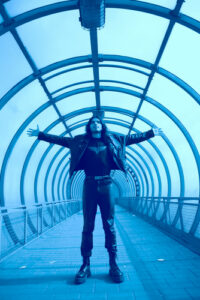 As he endeavored to paint the human being in motion, Leonardo da Vinci was the first to detect a “second form” of the body. This “second form” became visible in the circling movement around the body center and that of the limbs around their joints. Laban called these circling movements “trace-forms.”
As he endeavored to paint the human being in motion, Leonardo da Vinci was the first to detect a “second form” of the body. This “second form” became visible in the circling movement around the body center and that of the limbs around their joints. Laban called these circling movements “trace-forms.”
Laban stylized Leonardo’s circles, transforming them into rhythmic circles or polygons. “Polygons are circles in which there is a spatial rhythm,” he explained. “A triangle accentuates three points in the circumference of a circle, a quadrangle four points, a pentagon five points, and so forth.”
The ubiquity of circling movements has a deeper significance for Laban. He writes, “Our body is the mirror though which we become aware of the circling motions in the universe with their polygonal rhythms…. Each accent means a break of the circuit line, and the emergence of a new direction. These directions follow one another with infinite variations, deflections and deviations,” further embedding the moving body “in the great and universal flux.”
